The winter operations 1914-1915
23 November 1914 - 6 February 1915
Elements of the British Expeditionary Force which took part in these engagements:
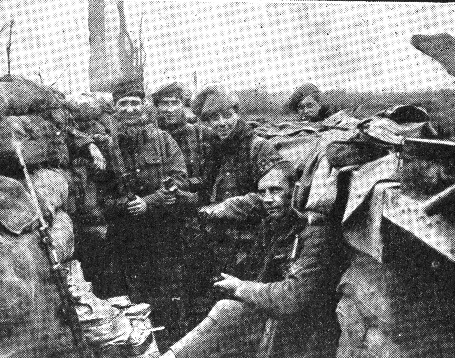
Soldiers of the London Scottish seem cheerful enough in the
sodden trenches of Flanders in the winter of 1914 to 1915.
The defence of Festubert, 23-24 November 1914
Order of battle:
Indian Corps (Willcocks): Meerut
Division
The attack on Wytschaete, 14 December 1914
Order of battle:
II Corps (Smith-Dorrien): 3rd
Division
French pressure on British to take the initiative
Based on information that the enemy was reducing his strength in France and Flanders, French Commander in Chief Joffre directed his armies to be ready to renew the offensive. On 7 December 1914 he sent a letter to General Foch, with a copy to Sir John French, with instructions that they should proceed with partial attacks in the Yser area and around Ypres without waiting for final preparations.
Urged on by pressure from the French to renew the offensive on the Western Front, British GHQ called a commanders conference on 12 December 1914. There would not be a simultaneous attack, but a series of Divisional actions in succession from the left, gradually spreading southwards.The first action would be the capture of Wytschaete and a wood, Petit Bois, in front of it, to be undertaken by French units with the 3rd Division. (This Division had been severely mauled at First Ypres, losing more than 8,000 men in a matter of days, less than a month ago). Success there would be followed by a II Corps attack on Spanbroekmolen, and then Messines. The Divisions were instructed to make no special artillery preparations for cutting barbed wire, although the infantry would be issued with wire-cutters and mattresses with which to climb over this obstacle.
8th Brigade is ordered to attack
For a commentary on the attack made by two battalions of 8th Brigade of 3rd Division, the 1st Gordon Highlanders under Major A. Baird and 2nd Royal Scots under Lt-Col. R. Dundas, we may turn to the diary comment by Billy Congreve. Billy was of military stock; his father a Brigadier-General with a VC. Billy himself was an exceptionally brave man who also later won the VC before being killed on the Somme. He was acting on the staff of the 3rd Division at this time. His comments - written on 15 December 1914 - are acid:
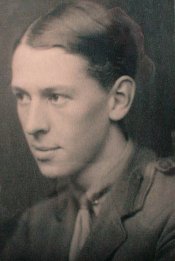 "Yesterday we made an attack and, as we only
put two battalions into it, the attack naturally failed.
We had about 400 casualties. It is very depressing. I
should have thought that we had learnt our lesson at
Neuve Chapelle [in October 1914] about unsupported attacks,
but it seems not. The truth of the matter is this I
believe: Sir John French wanted to see the Army on the
offensive, so an attack on the Petit
Bois was arranged. Then later, for some reason or other, it
was decided to also attack Maedelstede Farm. Sir John, Sir
H. Smith-Dorrien, HRH the Prince of Wales and many other
lights of the Gilded Staff sat about on the Scherpenberg,
and watched the preliminary bombardment by ours and the 5th
Division's artillery - and then saw these two unfortunate
battalions go to more or less certain failure. The reason
why? Because it was considered time to be able to report some
form of victory. It failed and the reason is obvious".
"Yesterday we made an attack and, as we only
put two battalions into it, the attack naturally failed.
We had about 400 casualties. It is very depressing. I
should have thought that we had learnt our lesson at
Neuve Chapelle [in October 1914] about unsupported attacks,
but it seems not. The truth of the matter is this I
believe: Sir John French wanted to see the Army on the
offensive, so an attack on the Petit
Bois was arranged. Then later, for some reason or other, it
was decided to also attack Maedelstede Farm. Sir John, Sir
H. Smith-Dorrien, HRH the Prince of Wales and many other
lights of the Gilded Staff sat about on the Scherpenberg,
and watched the preliminary bombardment by ours and the 5th
Division's artillery - and then saw these two unfortunate
battalions go to more or less certain failure. The reason
why? Because it was considered time to be able to report some
form of victory. It failed and the reason is obvious".
Click here to enlarge Billy Congreve's sketch map of the attack
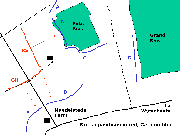 "A, B, C, D and E are the German trenches - B in
Petit Bois and D round Maedelstede Farm. RS are Royal Scots and GH the Gordons.
These two battalions were ordered respectively to take the wood and the farm.
What happened was that for half an hour or more our guns gave the German
trenches a very heavy and accurate fire with shrapnel and a smaller amount of
HE. The results of which made the Germans laugh at us. The effect of field gun
shrapnel on trenches is almost nil when the trenches are well and carefully
made, and there was too little high explosive to do any good. The Germans so
little minded this type of bombardment, which to us on the Scherpenberg looked
like an inferno, that they kept up a heavy rifle fire the whole time from the
bombarded trenches. The two battalions then attacked".
"A, B, C, D and E are the German trenches - B in
Petit Bois and D round Maedelstede Farm. RS are Royal Scots and GH the Gordons.
These two battalions were ordered respectively to take the wood and the farm.
What happened was that for half an hour or more our guns gave the German
trenches a very heavy and accurate fire with shrapnel and a smaller amount of
HE. The results of which made the Germans laugh at us. The effect of field gun
shrapnel on trenches is almost nil when the trenches are well and carefully
made, and there was too little high explosive to do any good. The Germans so
little minded this type of bombardment, which to us on the Scherpenberg looked
like an inferno, that they kept up a heavy rifle fire the whole time from the
bombarded trenches. The two battalions then attacked".
"The Royal Scots actually got into B, taking two machine-guns and 35 prisoners, but they were then so heavily enfiladed from A - and fired on from the back of Petit Bois - that further advance into the wood was impossible. Eventually they had to be content with holding on to part of the captured German trench. This enfilade fire that came from A held up the attack. This could have been found out by a proper reconnaissance before the attack. It was not done and, as A was neither attacked or shelled, the Germans holding it were able to shoot our fellows down one after another".
"The Gordons left their trenches to attack D and E and fared even worse. The mud on the ploughed field which they had to attack over was so bad that they could only just move out of a walk. On leaving their trenches they at once came under a terrible rifle and machine-gun fire from C, D and E. Imagine sending a battalion alone to attack a strongly wired position up a hill and over mud a foot deep, under frontal and enfilade fire. It was a regular Valley of Death. The losses were, of course, very heavy. They were very, very gallant. Some almost reached the German trenches, where they were killed. One or two even got into the trenches where they were killed or captured. A few lay in little depressions in the mud till darkness and then crawled back. Those who got there could send no communication to the supports etc in the rear. Several men tried to get back but were all shot. They lost 7 out of 9 officers and 250 men".
"Such was the attack ordered by Sir John French. Next day, I read in the
paper 'British troops hurl back Germans at Wytschaete'. A beautiful epitaph for
those poor Gordons who were little better than murdered".
Extract from "Armageddon Road: A VC's Diary 1914-1916" by Billy
Congreve, edited by Terry Norman, published 1982 William Kimber & Co.
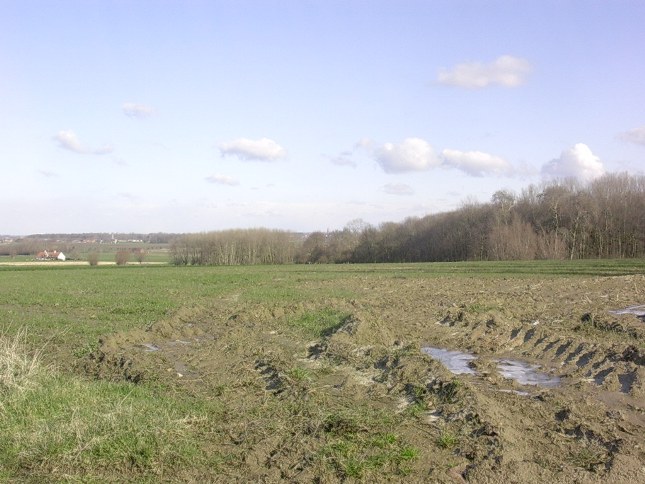
The ground over which the Royal Scots attacked, with Petit
Bois on the right
The defence of Givenchy, 20-21 December 1914
Order of battle:
Indian Corps (Willcocks): Lahore and
Meerut Divisions
Orders are received to attack at Givenchy...
Late on the night of 17 December 1914, Sir John French responded to pressure from his French allies to continue to harass the enemy and issued orders for II, III, IV and Indian Corps to attack vigorously all along their fronts the next day. This was despite the certain knowledge that similar attacks that had taken place a few days earlier had been repulsed with severe casualties. There was to be no change in approach. Frontal assaults by infantry would take place after a short bombardment - which the infantry already knew did insufficient damage to the enemy wire, trenches and machine gun posts. GHQ orders were imprecise in terms of stating the objective of theses attacks: they would only "demonstrate and seize any favourable opportunity which may offer to capture any enemy's trenches on their front". Artillery ammunition supplies were short, and no more than 40 rounds per gun would be fired; less for the heavier calibres - and most of that would be shrapnel, which was of little value for destroying wire or smashing strong points.
...andthe Indian Corps makes an attack
In the event II Corps did not attack, as the enemy actually attacked their French neighbours, disrupting plans. Elsewhere, a series of six disconnected and small-scale assaults took place. Where men entered the enemy lines - and they were few as the rest were held on the thick enemy wire - they were out-ranged by German hand grenades (the British had few, home made and quite useless grenades). The 7th and 8th Divisions quickly lost another 51 officers and 1024 men, having achieved next to nothing.
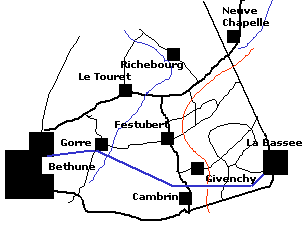 The Meerut and Lahore Divisions of the
Indian Corps had already suffered some 6,000 casualties since
arriving in Flanders a few weeks previously. Most of these had
been lost in the defence south of Ypres, but more recently they
had suffered in fruitless attacks in November and as recently as
16 December. They were exhausted, reeling from the debilitating
effects of trench warfare in the flooded ditches of Flanders. The
men lacked suitable winter clothing, and missed their accustomed
special rations. On 18 December, the Meerut held the left sector
of the Corps line, from La Bombe crossroads near Neuve Chapelle,
to Picquet House near La Quinque Rue at Festubert. Extending
to the right, the Lahore held the line to Givenchy,
with one battalion, the 1st Connaught Rangers, on the opposite
bank of the La Bassée Canal. The Corps attacked at 3.10am on the
cold, windy, rainy early morning of 19 December 1914.
The Meerut and Lahore Divisions of the
Indian Corps had already suffered some 6,000 casualties since
arriving in Flanders a few weeks previously. Most of these had
been lost in the defence south of Ypres, but more recently they
had suffered in fruitless attacks in November and as recently as
16 December. They were exhausted, reeling from the debilitating
effects of trench warfare in the flooded ditches of Flanders. The
men lacked suitable winter clothing, and missed their accustomed
special rations. On 18 December, the Meerut held the left sector
of the Corps line, from La Bombe crossroads near Neuve Chapelle,
to Picquet House near La Quinque Rue at Festubert. Extending
to the right, the Lahore held the line to Givenchy,
with one battalion, the 1st Connaught Rangers, on the opposite
bank of the La Bassée Canal. The Corps attacked at 3.10am on the
cold, windy, rainy early morning of 19 December 1914.
The attack gains a toehold in the enemy front line
The 2nd Leicesters of Gharwal Brigade, supported by the 2/3rd Gurkhas, attacked at 3.15am, and despite having to cross a field of machine gun fire managed to capture a length of 300 yards of the enemy front line near Festubert. They held on through the dawn against numerous bombing attacks delivered along the network of communication trenches. By 10.00am, the enemy was seen massing for a counter-attack near the Orchard, which was being mortared. The most advanced men were withdrawn to a line to the rear of the Orchard. A little way south, the 1st Highland Light Infantry and 1/4th Gurkha Rifles of the newly-arrived Sirhind Brigade and 59th Scinde Rifles of Jullundur Brigade attacked in front of Givenchy. They also got into 200 yards of the lightly-held enemy front line, but casualties were heavy as the enemy counter-attacked again and again, and men crossing no man's land in support were scythed down by machine gun fire.
The enemy counter-attacks in force
German retaliation to this attack and those of previous days was swift and heavy. From dawn on 20 December, in torrential rain and cold, the enemy artillery subjected the front trenches of Indian Corps to a deluge of high explosive shells, which was also supplemented by trench mortars firing from the German lines. They blew 10 small mines under the British lines at Givenchy about 9.00am, and followed this by a strong infantry attack. The mines killed or buried many men. The enemy infantry penetrated 300 yards into the Sirhind Brigade lines near Festubert, where hand to hand fighting took place. It appeared as though Givenchy, would have to be evacuated if the garrison (the 1st Manchesters) was not to be surrounded. A German report later showed that 19 British officers and 815 other ranks were taken prisoner.
Fresh troops stabilise the situation
During the afternoon of the 20 December, I Corps sent 1st (Guards) and 3rd Brigades to the assistance of the hard-pressed Indian Corps. 2nd Brigade arrived by bus later in the day. Delayed by dark, water-logged ground and machine-gun fire, they eventually relieved the Manchesters in Givenchy and the remnants of Sirhind Brigade at Festubert. GHQ ordered Haig's I Corps to relieve the shattered Indian Corps, which took place by 22 December. The 1st Division suffered 1,682 casualties in the operations to relieve the Indian Corps. Many of these, and many of the Indian Corps, were victims of exposure and frostbite as they held on without cover in freezing rain and flooded trenches for two or three days.
Joffre closes down the offensive for the winter
Following the failure at Wytschaete and the fighting at Givenchy, none of the other planned attacks followed. Shelling of the German lines merely brought down a much heavier retaliation. Joffre closed down the offensive. The sacrifice of the Scots battalions proved again the difficulty of an infantry attack upon entrenched positions that had not been suppressed, through barbed wire that was still intact. Next time, more artillery firing more HE, more thorough reconnaissance, wire cutting in advance, better ways to feed messages back - and a wider attack - would be necessary. These lessons were applied at the next serious British attack, at Neuve Chapelle on 10 March 1915.
The losses of December 1914 were bitter; they had been incurred for no tactical gain and for command objectives that were known to be uncertain and questionable. Many potential leaders and seasoned regular troops were lost - men who would have been a vital backbone for the New Armies that would come in 1915. The burial of many bodies of comrades lying in the frost and bloody pools of no man's land was one of the motivations for the Christmas fraternisation that soon occurred in this area.
British senior officer casualties
Lt-Col Robert Brewis, OC 2nd Royal Warwicks, died of wounds on 18
December 1914. He is buried at Sailly sur la Lys Churchyard cemetery.
Lt-Col
Henry Lempriere, OC 7th Dragoon Guards, died on 23 December 1914. He
is commemorated on the Le Touret Memorial to the Missing.
Lt-Col Reginald Alexander, OC 3rd Rifle Brigade, died of his wounds
on 29 December 1914. He is buried in Bailleul Communal Cemetery.
Indian Corps casualties since it came into the line in October
| Casualties incurred | Killed or missing | Wounded | ||
| Indian Corps | Officers | Men | Officers | Men |
| British | 144 | 915 | 148 | 1246 |
| Indian | 70 | 2590 | 96 | 4370 |
| Source: "The Indian Corps in France" (Merewether and Smith) | ||||
| Total 9579 | ||||
The First Action of Givenchy, 25 January
1915
Order of battle:
First Army (Haig): Note: First and Second Armies had been created on 26 December
1914
I Corps (Monro): 1st Division
The affairs of Cuinchy: 29 January, 1 and 6 February 1915
Order of battle:
First Army (Haig):
I
Corps (Monro): 1st Division (29 Jan) and 2nd Division (1 and 6 Feb)
 reddit
reddit